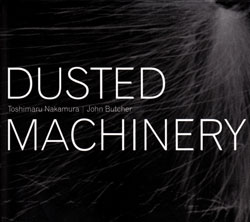
Behold Toshimaru Nakamura, a modern-day musical innovator who is redefining sound. Nakamura started out as a rock 'n' roll guitarist, but over the years he has evolved to what's known as a no-input mixing board, where the input of the board is connected to the output, and the resulting audio feedback is manipulated by Nakamura. He's one of the key players in the Japanese Onkyo movement, which emphasizes sound texture rather than musical structure. On his new CD Dusted Machinery, Nakamura is joined by the talented English saxophonist John Butcher. It's not clear how many jazz musicians have a PhD in physics, but Butcher is one of them; after studying spin effects in heavy quarks, he left academia to focus on being a musician. Butcher started out playing conventional jazz and gradually became an avant-free convert, and for the past decade Nakamura has been one of his closest musical compatriots.
The four pieces on Dusted Machinery are absolutely thrilling. Each piece consists of Butcher on sax and Nakamura on no-input mixing board, yielding a sonic atmosphere with fabulous layers that are impossible to anticipate. In fact that's the beauty of this CD — there are absolutely no expectations to be had, there's just the sounds coming at you. The saxophone is recognizable as a memory of itself, one that's been shattered into a thousand sonic pixels. It's the merciless, pitiless sound of machinery, and yet there's an elegance here, with something undeniably vital and indispensable at work — this is the sound of neurons firing, maybe fighting, perhaps even praying. There's a very particular aura about this music; it's holy metallic noise, a robotic Jack Kerouac sound-poem full of electronic bouquets.
One of the many exciting things about this music is that it allows you to hear wider and longer. These out-of-earshot sounds invite — nay, commandeer — your ears into spanking-new territory. It's music outside the land of right and wrong; there's no "in tune" or "out of tune" in this galaxy. And by creating these new sound-worlds, Nakamura and Butcher are also creating the ability to hear them. Happily, this expansion doesn't stop with the music: these pieces not only expand concepts of sound, but they also expand the language one might use to describe them, or the shapes and colors one might use to depict them. And who knows where things could go from there?
This is not the CD to put on when your landlady drops by for tea. This is the CD to put on if you are willing to enter a singular aural universe. Where do these sounds exist? Maybe this is the vocabulary on other planets, and maybe this could become our vocabulary one day. Maybe this already is our vocabulary, but we just don't know it — yet.
Comments and Feedback:



More Recent Reviews, Articles, and Interviews @ The Squid's Ear...


|

